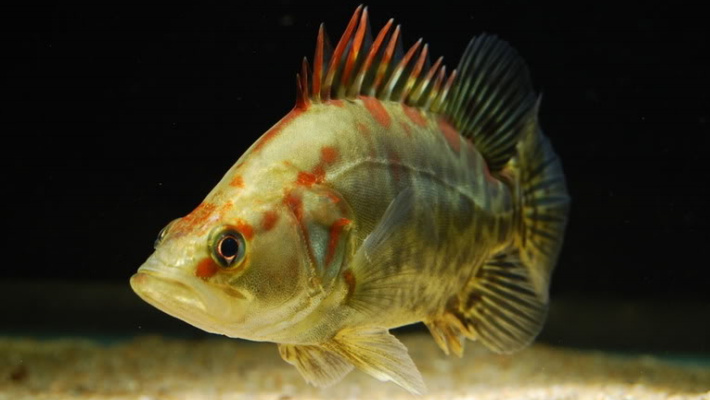|
Because
fresh waters are optically turbid in comparison with pure sea waters, curves of
photopic spectral sensitivity in freshwater fish are strongly displaced to the red part of the spectrum. It means that
for eyes of freshwater fish orange (585-620 nm) and red (longer than 620 nm),
depending on the value of displacement, colors are brighter than all other
equipower monochromatic colors. Red colors are
located commonly on the under shadowed parts of the fish’s body (like the lower
fins), in conformity with the theory of color countershading in fresh waters.
On the
contrary, in many freshwater fish red and other colors are located on the upper
most illuminated parts of the body. Colors with this location become conspicuous
both for social mates and predators. There are many strategies in fish to find
trade-offs between these extreme positions that, however, will not be
considered here.
Colored Body
No doubts,
the most known example of coloration of this type in freshwater fish is nuptial
coloration of anadromous sockeye salmon, Oncorhynchus
nerka, that they acquire in the home rivers in the reproductive period.
Breeding sockeye salmons have the olive-green heads and conspicuous carotenoid
based red bodies in both sexes but brighter in males (Foot et al., 2004). According
to the same authors, in field experiments males of O. nerka show preferences to abstract female models of red color
over models of other colors in pre-spawning period, but choose only red models
during spawning.
According
to spectroscopic measurements (Foot et al.,, 2004), green color of the head and
red color of the body form an exactly matched pair of complementary colors that
is extremely conspicuous (Endler, 1992).
Another
example is black nuptial coloration in males of Ponto-Caspian gobiid fish which
readily migrate into the freshwater rivers of this basin and breed here (beeing
also invaders). Round goby, Neogobius
melanostomus, monkey goby, N.
fluviatilis, ratan goby, N. ratan,
black goby, Gobius niger, and racer goby, Mesogobius gymnotrachelus, are among
them. In general, black
coloration of males repel rivals and is more attractive for females than
mottled one (see data by Yavno, 2010, for round goby, N.
melanostomus).
Black and
white mollies, Poecilia latipinna,
prefer to aggregate with conspecifics of the same body coloration (McRobert &
Bradner, 1998; Bradner & McRobert, 2001).
Colored Stripes
Bilateral
longitudinal red (orange)
stripes are basic
elements of nuptial coloration in males of the anadromous Far-Eastern dace, Tribolodon brandtii (Cyprinidae), and
related daces. On the flanks of tribolodons, one of red stripes is located ventrally,
another is located dorsally beeing very visible.
Neon tetra,
Paracheirodon innesi, cardinal tetra, Cheirodon
axelrodi, and some other characins, which inhabit optically turbid blackwater
streams and flood lagoons of the Amazon basin, have extremely bright coloration
with lateral blue or blue-green stripes and red rear abdominal area (e.g., Lythgoe
& Shand, 1983; Ikeda
& Kohshima, 2009).
Precisely, brilliantly colored lateral stripes are located above the line of
the body covexity that is on the most illuminated part of the body.
For
comparison, the same patterns with longitudinal colored stripes occur in many
marine fish. In Elacatinus gobies, for example, colored high contrast stripes, located on the sides centrally or dorsally, are
signals of cleaning service on coral reefs (e.g., Lettieri et al., 2009; Cheney
et al., 2009). Longitudinal patterns with some stripes are more attractive for
clients than cross banded patterns.
Mixed Patterns
Females of fighting
fish, Betta splendens, display readiness to associate with conspecific
females depending on coloration of their body that varies dramatically in this
species (Blakeslee et al., 2009). Uniformly colored white fish and fish with
brown longitudinal stripes prefer to associate with conspecifics of matched body
coloration.
Rothenthal
& Ryan (2005) have studied schooling preferences in wild zebrafish, Danio rerio, two artificially selected strains (gold and leopard) with reduced stripe expression, stripeless
D. albolineatus and striped D. nigrofasciatus. Each species and
strain of Danio prefer the phenotype
that most resembles its own, with preference for striped stimuli by fish with
dark-stripe phenotypes and preference for no stripes by fish lacking stripes
(for more details, see Snekser et al., 2010).
Basic References
Blakeslee C.,
McRobert S.P., Brown A.C., Clotfelter E.D. 2009. The effect of body coloration
and group size on social partner preferences in female fighting fish (Betta splendens). Behavioural Processes 80, 157-161
Bradner J.,
McRobert S.P. 2001. The effect of shoal size on patterns of body colour
segregation in mollies. Journal of Fish Biology
59, 960-967
Cheney K.L., Grutter A.S., Blomberg S.P., Marshall N.J.
2009. Blue and yellow signal cleaning behavior in coral
reef fishes. Current Biology 19, 1283-1287
Endler J.A.
1992. Signals, signal
conditions, and the direction of evolution. American
Naturalist 139,
S125-S153
Foote C.J.,
Brown G.S., Hawryshyn C.W. 2004. Female colour and male choice in
sockeye salmon: implications for the phenotypic convergence of andromous and
nonanadromous morphs. Animal
Behaviour 67, 69-83
Ikeda T., Kohshima S. 2009. Why is the neon tetra so
bright? Coloration for mirror-image projection to confuse predators? "Mirror-image
decoy” hypothesis. Environmental Biology of Fishes 86, 427-441
Lettieri L., Cheney K.L., Mazel C.H., Boothe D., Marshall
N.J., Streelman J.T. 2009. Cleaner gobies evolve advertising stripes of higher
contrast. Journal of Experimental Biology
212, 2194-2203
Lythgoe J.N., Shand J. 1983. Diel colour changes in the
neon tetra Paracheirodon innesi. Environmental Biology of Fishes 8, 249-254
McRobert S.P.,
Bradner J. 1998. The influence of body coloration on shoaling preferences in
fish. Animal behaviour 56, 611-615
Rothenthal
G.G., Ryan M.J. 2005. Assortative
preferences for stripes in danios. Animal
Behaviour 70, 1063-1066
Snekser
J.L., Ruhl N., Bauer K., McRobert S.P. 2010. The influence of sex and phenotype on
shoaling decisions in zebrafish. International
Journal of Comparative Psychology 23,
70-81
Yavno S.
2010. Behavioural
responses of the Round Goby, Neogobius
melanostomus, to signals from conspecifics. University of Windsor
|








 SUBSCRIBE
SUBSCRIBE


